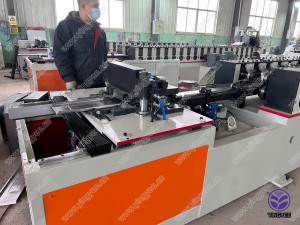
PLC Adjustment Guide for Storage Upright Rack Roll Forming Machine with Hydraulic Cutting
In the modern manufacturing landscape, storage systems play a pivotal role in optimizing space and enhancing operational efficiency. One of the most widely utilized systems is the upright rack, which provides robust storage solutions for various industries. To meet the diverse needs of storage configuration, roll forming machines equipped with hydraulic cutting functionality have emerged as a preferred choice. This article outlines a PLC adjustment guide for these machines, helping operators achieve optimal performance.
Overview of Roll Forming Machines
A roll forming machine is designed to shape metal sheets into specific profiles through a series of rollers. These machines are instrumental in the production of components for storage systems, ensuring consistency and high-quality output. The addition of hydraulic cutting technology enhances the capabilities of roll forming machines, allowing for precise cuts and reducing material waste.
Importance of PLC Control
Programmable Logic Controllers (PLCs) are integral to the automation of roll forming machines. They manage operational parameters, monitor machine performance, and ensure seamless integration of various processes. PLCs allow operators to adjust settings quickly, making them essential for maintaining high productivity levels while managing different production runs.
Key Adjustments to Consider
1. Speed Settings The speed of the roll forming machine is crucial for achieving the desired quality and efficiency. Operators should adjust the PLC settings to calibrate the speed based on the thickness and type of material being processed. Too fast a speed may lead to defects, while too slow can impede productivity.
2. Roller Positioning Proper alignment of rollers is vital for uniform shaping. The PLC can be programmed to adjust the positioning dynamically, ensuring that changes in material thickness are accounted for. Regular tuning may be necessary to ensure precision.

3. Hydraulic Pressure Hydraulic cutting relies on the correct application of force. The PLC should be configured to monitor and adjust hydraulic pressure in real-time. This will help achieve clean cuts, especially in thicker materials, while preventing excessive wear on the cutting blades.
4. Cutting Length Calibration Accurate cutting lengths are paramount for fitting components into the storage racks. The PLC allows for precise input of desired lengths, which can be adjusted on-the-fly as production requirements change. Ensuring that the cutting mechanism is synchronized with the roll forming process enhances workflow efficiency.
5. Fault Detection and Alarming Implementing advanced monitoring through PLCs can prevent significant downtimes. Operators should ensure that the PLC is programmed to detect anomalies and trigger alarms for early intervention. Regular diagnostics will help maintain the health of the machine and improve lifespan.
Best Practices for Adjustment
- Training Operators should be thoroughly trained in the use of PLC systems to make real-time adjustments effectively. Familiarity with the software and hardware components will enhance operational efficiency. - Regular Maintenance Routine maintenance checks ensure that both the roll forming and hydraulic systems function optimally. Any wear and tear should be addressed immediately to prevent production delays.
- Documentation Keeping a detailed log of all adjustments made to the PLC settings will provide operators with a reference point for future adjustments and help troubleshoot issues as they arise.
Conclusion
The integration of PLC technology within storage upright rack roll forming machines equipped with hydraulic cutting features revolutionizes the production process. By focusing on key adjustments related to speed, positioning, pressure, cutting length, and fault detection, operators can significantly enhance their operational capabilities. Emphasizing best practices in training, maintenance, and documentation will ensure that these machines operate at peak performance, ultimately contributing to the efficient storage solutions demanded by various industries. With proper adjustment and monitoring, manufacturers can optimize resources, reduce waste, and improve overall productivity.